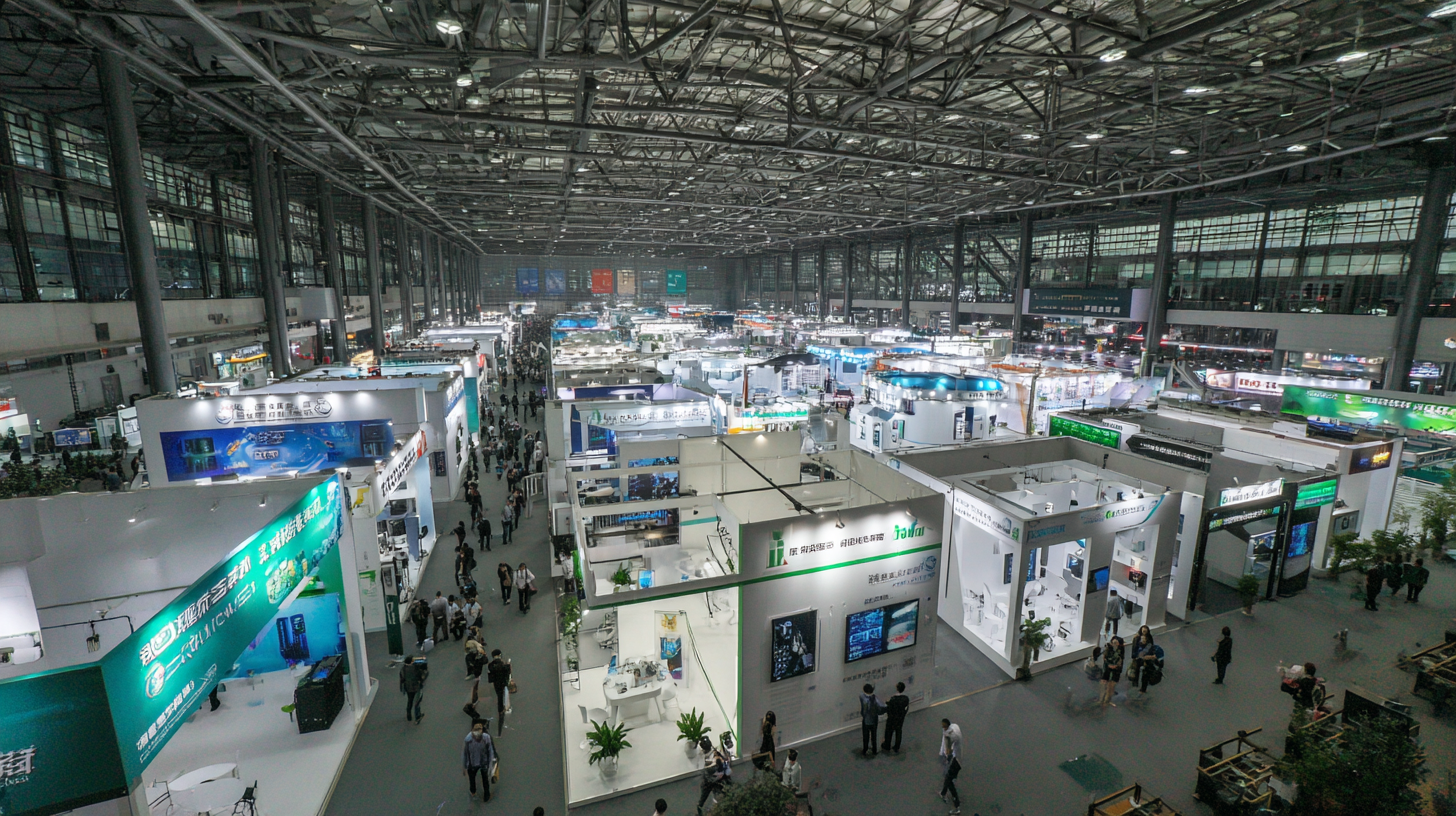As the 138th China Import and Export Fair (Canton Fair) approaches in 2025, the spotlight is set to shine on groundbreaking technologies reshaping industries, notably laser direct imaging (LDI). This innovative technique, which enhances precision in printed circuit board manufacturing, is increasingly recognized for its ability to significantly reduce production costs and time, as well as improve product reliability. According to a recent report by ResearchAndMarkets, the LDI market is projected to grow at a CAGR of 12.5% from 2021 to 2026, driven by the rising demand for miniaturized electronic devices. The Canton Fair provides an unparalleled platform for showcasing advancements in LDI technologies, fostering collaboration among key industry players, and highlighting China's pivotal role in the global electronics supply chain. Attendees can expect to see cutting-edge applications of laser direct imaging that promise to revolutionize manufacturing processes and propel the electronics sector into a new era of efficiency and innovation.

At the upcoming 2025 China Export Commodities Fair, the spotlight will be on the transformative technologies reshaping PCB manufacturing, particularly through innovative applications of Laser Direct Imaging (LDI). This cutting-edge technique enables precise patterning on printed circuit boards, significantly enhancing the resolution and speed of production. By utilizing laser beams to directly transfer designs onto photosensitive substrates, manufacturers can achieve intricate layouts that traditional lithographic methods often struggle to replicate.
This innovation not only boosts efficiency but also reduces material waste, making it a more sustainable option for PCB production. Companies are now able to produce complex multi-layer boards with reduced cycle times, which can meet the increasing demand for compact and high-performance electronic devices. Furthermore, the ability to rapidly adapt designs and modify production runs holds great appeal for industries such as consumer electronics and automotive, where rapid innovation is key. As these applications continue to evolve, the 2025 fair will serve as a crucial platform for showcasing advancements in LDI technology and its impact on the future of PCB manufacturing.

The integration of Laser Direct Imaging (LDI) technology in manufacturing is revolutionizing production efficiency and cost management in various sectors. Recent reports from industry analysts highlight that LDI can significantly enhance production speed, with manufacturers experiencing up to a 30% reduction in cycle times. This technology allows for precise imaging directly onto substrates, minimizing the need for traditional photomask processes that often lead to higher material costs and longer lead times. As organizations seek to streamline operations, LDI emerges as a critical asset for companies aiming to maintain competitive pricing while increasing output.
Moreover, the implementation of LDI systems has been shown to reduce waste by as much as 25%. This is particularly crucial in the printed circuit board (PCB) industry, where material usage directly impacts profitability. By adopting LDI, manufacturers not only cut down on raw materials but also streamline their workflows, leading to a more sustainable production model. Reports indicate that firms implementing this technology can see a noticeable decrease in total manufacturing costs, projecting an average savings of 15-20% in operational expenses. As the 2025 China Export Commodities Fair showcases innovations in the field, the spotlight on LDI's role in enhancing efficiency and reducing costs will undoubtedly foster further advancements and adoption across industries.
At the forefront of manufacturing advancements, Laser Direct Imaging (LDI) is revolutionizing production processes by integrating with cutting-edge technologies. As highlighted in a recent report by MarketsandMarkets, the global LDI market is projected to grow from USD 467 million in 2021 to USD 1.24 billion by 2026, at a compound annual growth rate (CAGR) of 21.2%. This surge can be attributed to the increasing demand for miniaturization in electronic components and the corresponding need for more precise imaging techniques.
The synergy between LDI and advanced manufacturing technologies such as 3D printing and AI-driven design systems is particularly notable. By employing LDI, manufacturers can achieve enhanced resolution and accuracy in circuit board production, leading to significant reductions in material waste. A report from TechNavio also emphasizes that companies adopting LDI can reduce their production cycles by up to 30%, thereby increasing overall efficiency.
Tips: When considering LDI integration, manufacturers should evaluate their current production processes and identify areas for optimization. Moreover, investing in training for staff in LDI technology can help harness its full potential, ensuring maximum returns on investment. Emphasizing collaboration between engineers and designers during the LDI setup can further enhance the advantages offered by this innovative imaging technique.
| Innovation Type | Technology Integration | Application Sector | Benefits | Market Potential |
|---|---|---|---|---|
| High-Precision Laser Direct Imaging | AI-Assisted Design | Electronics | Reduced Waste, Increased Accuracy | High |
| 3D Laser Imaging | Robotics Integration | Aerospace | Enhanced Design Capabilities | Medium |
| UV Laser Imaging | Nanotechnology | Medical Devices | Higher Efficiency and Precision | High |
| Laser Etching Technology | IoT Connectivity | Consumer Goods | Customization and Personalization | Medium |
| Green Laser Technology | Energy-Efficient Machines | Telecommunications | Lower Environmental Impact | High |
As the 2025 China Export Commodities Fair approaches, the spotlight will be on the latest advancements in Laser Direct Imaging (LDI) technology. This event will showcase global leaders in LDI, underscoring the crucial role this innovation plays in various industries, including textiles and manufacturing. Recent reports suggest that the global LDI market is expected to grow at a compound annual growth rate (CAGR) of 10.2% from 2023 to 2030, driven by increasing demand for high-precision imaging techniques in the printing and packaging sectors.

Exhibitors at the fair will present groundbreaking applications that leverage LDI to enhance efficiency and reduce waste. For instance, notable innovations in dye sublimation fabric cutting technology demonstrate how laser imaging can improve production accuracy and speed. As the industry moves towards more sustainable practices, LDI technologies offer solutions that minimize material consumption while maintaining high-quality output, positioning them as essential tools for manufacturers aiming for eco-friendly operations.
This year's fair is not just an exhibition; it's a glimpse into the future of precision imaging and its transformative impact across industries.
As laser direct imaging (LDI) technology continues to evolve, its applications in various industries are expanding significantly. The 2025 China Export Commodities Fair serves as a pivotal platform for showcasing the latest innovations in LDI, highlighting its crucial role in enhancing manufacturing precision and efficiency. The advancements in laser imaging allow for finer details in production, enabling manufacturers to create complex designs with unprecedented accuracy.
Future trends in laser direct imaging technology point towards integration with artificial intelligence and machine learning. These integrations promise to automate and optimize the imaging process, reducing human error and enhancing production speed. Moreover, as sustainability becomes increasingly important, LDI's reduced material waste and energy consumption make it an attractive option for responsible manufacturing practices. The synergy of these technologies is likely to redefine industry standards, fostering a new age of automated and environmentally friendly production solutions.






„Thanks to the LUVIR technology, the solder resist process could be switched directly from the previously used mask exposure to direct exposure. As an outstanding digital solution on the market, this technology has been able to demonstrate fast process times and superior quality on our certified conventional ink in production. This allowed us to fully digitize the solder mask process at low cost – without process or ink adjustments. An excellent benefit to our production in Rot am See.“
Ralf Göhringer (Head of Production WE Rot am See)
I would definitely recommend the Limata machine and team for a future company purchase
Michael Greenaway
Compunetics Inc.
“The Limata ldi has been amazing!! Best thing we did was buy this machine”
Richard Brady
GM
Circuitlabs
“Since 2019, we have been running the Limata X1000 LDI system (including LUVIR for solder mask imaging) in daily production as an addition to our current process with film. The machine was capable of properly exposing Taiyo PSR-4000 BN (DI) solder mask types on normal to high-copper boards using a new and unique direct imaging process. The machine operating interface is very user friendly which allowed for a quick technical training curve. The pre-registration processing reduced several seconds of production time at every print. Limata support and service staff is incomparable. They supported our team every step of the way at basically any time of the day or night, with literally, an immediate response time, customizing the software interface to best fit our Operations and needs.
We have exposed more than 8,000 prints since end of October, on various solder mask colors and some resist film panels. Limata, has proven to be very capable and innovative. They are a strong contender in the industry.
We have very much enjoyed this project, and working with the team!
Thank you Limata for the continued support and being a part of our growth.”
Bill Sezate
Vice President, GM
Summit Interconnect
As a replacement to our current contact exposure process with film, the LIMATA X2000 system including LUVIR-Technology was capable of properly exposing non-LDI solder mask types using a direct imaging process. The machine offers cutting edge software with a very intuitive operating interface which allowed for quick technician training curve. The dual drawer system combined with pre-registration processing reduced several seconds of production time at every machine cycle. Limata support and service staff is world class. They added software patches to keep production running at shortest possible response times, customized the software interface to best fit our in-house Operations system, and even wrote a step-by-step machine processing manual. As a result of the project, we have exposed more than 16,000 times on various product types and solder mask brands/colors. Limata, in a very short timeframe as a company, has definitely shown they are truly innovative and will be challenging the industry of direct imaging for the top spot.
Kevin Beattie
Process Engineer
TTM Technologies
Forest Grove Division